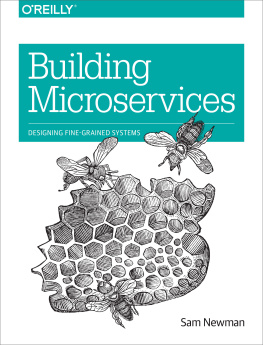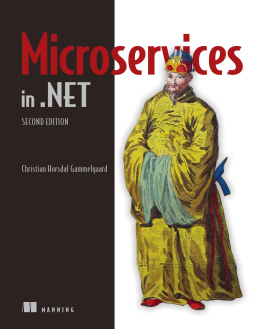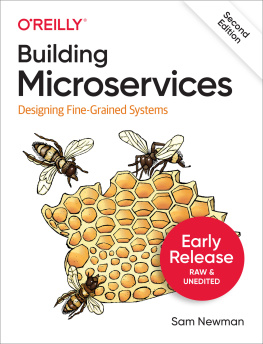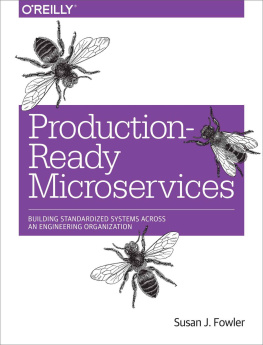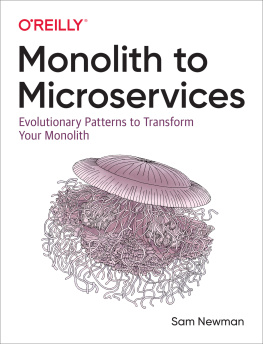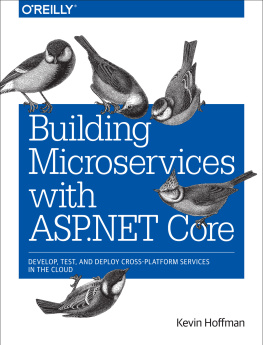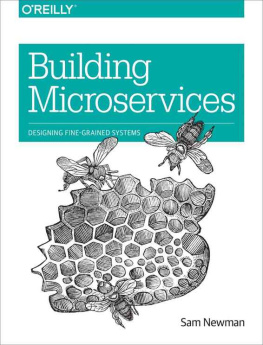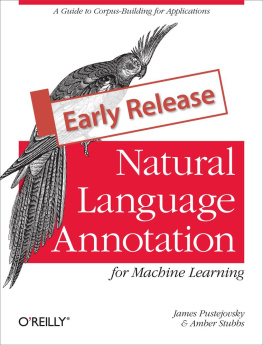Newman - Building Microservices
Here you can read online Newman - Building Microservices full text of the book (entire story) in english for free. Download pdf and epub, get meaning, cover and reviews about this ebook. City: Sebastopol;CA, year: 2015, publisher: OReilly Media, Inc., genre: Business. Description of the work, (preface) as well as reviews are available. Best literature library LitArk.com created for fans of good reading and offers a wide selection of genres:
Romance novel
Science fiction
Adventure
Detective
Science
History
Home and family
Prose
Art
Politics
Computer
Non-fiction
Religion
Business
Children
Humor
Choose a favorite category and find really read worthwhile books. Enjoy immersion in the world of imagination, feel the emotions of the characters or learn something new for yourself, make an fascinating discovery.
Building Microservices: summary, description and annotation
We offer to read an annotation, description, summary or preface (depends on what the author of the book "Building Microservices" wrote himself). If you haven't found the necessary information about the book — write in the comments, we will try to find it.
Newman: author's other books
Who wrote Building Microservices? Find out the surname, the name of the author of the book and a list of all author's works by series.
Building Microservices — read online for free the complete book (whole text) full work
Below is the text of the book, divided by pages. System saving the place of the last page read, allows you to conveniently read the book "Building Microservices" online for free, without having to search again every time where you left off. Put a bookmark, and you can go to the page where you finished reading at any time.
Font size:
Interval:
Bookmark:
by Sam Newman
Copyright 2015 Sam Newman. All rights reserved.
Printed in the United States of America.
Published by OReilly Media, Inc. , 1005 Gravenstein Highway North, Sebastopol, CA 95472.
OReilly books may be purchased for educational, business, or sales promotional use. Online editions are also available for most titles (http://safaribooksonline.com). For more information, contact our corporate/institutional sales department: 800-998-9938 or corporate@oreilly.com .
- Editors: Mike Loukides and Brian MacDonald
- Production Editor: Kristen Brown
- Copyeditor: Rachel Monaghan
- Proofreader: Jasmine Kwityn
- Indexer: Judith McConville
- Interior Designer: David Futato
- Cover Designer: Ellie Volckhausen
- Illustrator: Rebecca Demarest
- February 2015: First Edition
- 2014-01-30: First Release
See http://oreilly.com/catalog/errata.csp?isbn=9781491950357 for release details.
The OReilly logo is a registered trademark of OReilly Media, Inc. Building Microservices, the cover image of honey bees, and related trade dress are trademarks of OReilly Media, Inc.
While the publisher and the author have used good faith efforts to ensure that the information and instructions contained in this work are accurate, the publisher and the author disclaim all responsibility for errors or omissions, including without limitation responsibility for damages resulting from the use of or reliance on this work. Use of the information and instructions contained in this work is at your own risk. If any code samples or other technology this work contains or describes is subject to open source licenses or the intellectual property rights of others, it is your responsibility to ensure that your use thereof complies with such licenses and/or rights.
978-1-491-95035-7
[LSI]
Microservices are an approach to distributed systems that promote the use of finely grained services with their own lifecycles, which collaborate together. Because microservices are primarily modeled around business domains, they avoid the problems of traditional tiered architectures. Microservices also integrate new technologies and techniques that have emerged over the last decade, which helps them avoid the pitfalls of many service-oriented architecture implementations.
This book is full of concrete examples of microservice use around the world, including in organizations like Netflix, Amazon, Gilt, and the REA group, who have all found that the increased autonomy this architecture gives their teams is a huge advantage.
The scope of this book is broad, as the implications of fine-grained microservice architectures are also broad. As such, it should appeal to people interested in aspects of design, development, deployment, testing, and maintenance of systems. Those of you who have already embarked on the journey toward finer-grained architectures, whether for a greenfield application or as part of decomposing an existing, more monolithic system, will find plenty of practical advice to help you. It will also help those of you who want to know what all the fuss is about, so that you can determine whether microservices are right for you.
I started thinking about the topic of application architectures many years ago, when working to help people deliver their software faster. I realized that while infrastructure automation, testing, and continuous delivery techniques could help, if the fundamental design of the system doesnt make it easy to make changes, then there are limits to what can be accomplished.
At the same time, many organizations were experimenting with finer-grained architectures to accomplish similar goals, but also to achieve things like improved scaling, increasing autonomy of teams, or to more easily embrace new technologies. My own experiences, as well as those of my colleagues at ThoughtWorks and elsewhere, reinforced the fact that using larger numbers of services with their own independent lifecycles resulted in more headaches that had to be dealt with. In many ways, this book was imagined as a one-stop shop that would help encompass the wide variety of topics that are necessary for understanding microservicessomething that would have helped me greatly in the past!
Microservices is a fast-moving topic. Although the idea is not new (even if the term itself is), experiences from people all over the world, along with the emergence of new technologies, are having a profound effect on how they are used. Due to the fast pace of change, I have tried to focus this book on ideas more than specific technologies, knowing that implementation details always change faster than the thoughts behind them. Nonetheless, I fully expect that in a few years from now well have learned even more about where microservices fit, and how to use them well.
So while I have done my best to distill out the essence of the topic in this book, if this topic interests you, be prepared for many years of continuous learning to keep on top of the state of the art!
This book is primarily organized in a topic-based format. As such, you may want to jump into the specific topics that interest you the most. While I have done my best to reference terms and ideas in the earlier chapters, Id like to think that even people who consider themselves fairly experienced will find something of interest in all chapters here. I would certainly suggest that you take a look at , which touches on the breadth of the topic as well as providing some framing for how I go about things in case if you want to dive deeper into some of the later topics.
For people new to the subject, Ive structured the chapters in a way that I hope will make sense to read from beginning to end.
Here is an overview of what we cover:
Well begin with an introduction to microservices, including the key benefits as well as some of the downsides.
This chapter discusses the difficulties we face in terms of making trade-offs as architects, and covers specifically just how many things we need to think about with microservices.
Here well start to define the boundary of microservices, using techniques from domain-driven design to help focus our thinking.
This is where we start getting a bit deeper into specific technology implications, as we discuss what sorts of service collaboration techniques will help us most. Well also delve into the topic of user interfaces and integrating with legacy and commercial off-the-shelf (COTS) products.
Many people get interested in microservices as an antidote to large, hard-to-change monolithic systems, and this is exactly what well cover in detail in this chapter.
Although this book is primarily theoretical, few topics in the book have been as impacted by recent changes in technology as deployment, which well explore here.
This chapter goes deep into the topic of testing, an area of particular concern when handling the deployment of multiple discrete services. Of particular note will be the role that consumer-driven contracts can play in helping us ensure the quality of our software.
Testing our software before production doesnt help if problems occur once we go live, and this chapter explores how we can monitor our fine-grained systems and deal with some of the emergent complexity of distributed systems.
Here well examine the security aspects of microservices and consider how to handle user-to-service and service-to-service authentication and authorization. Security is a very important topic in computing, one that is all too readily ignored. Although I am in no way a security expert, I hope that this chapter will at least help you consider some of the aspects you need to be aware of when building systems, and microservice systems in particular.
Font size:
Interval:
Bookmark:
Similar books «Building Microservices»
Look at similar books to Building Microservices. We have selected literature similar in name and meaning in the hope of providing readers with more options to find new, interesting, not yet read works.
Discussion, reviews of the book Building Microservices and just readers' own opinions. Leave your comments, write what you think about the work, its meaning or the main characters. Specify what exactly you liked and what you didn't like, and why you think so.

